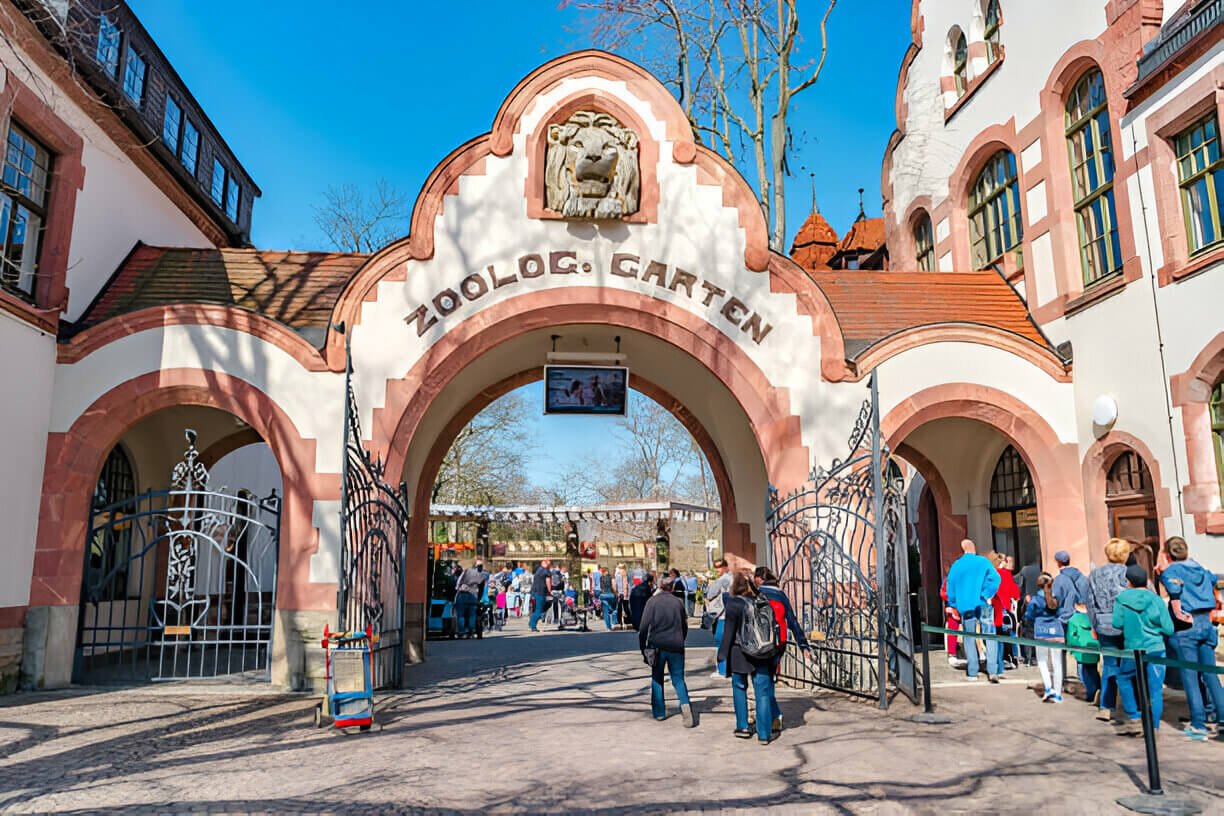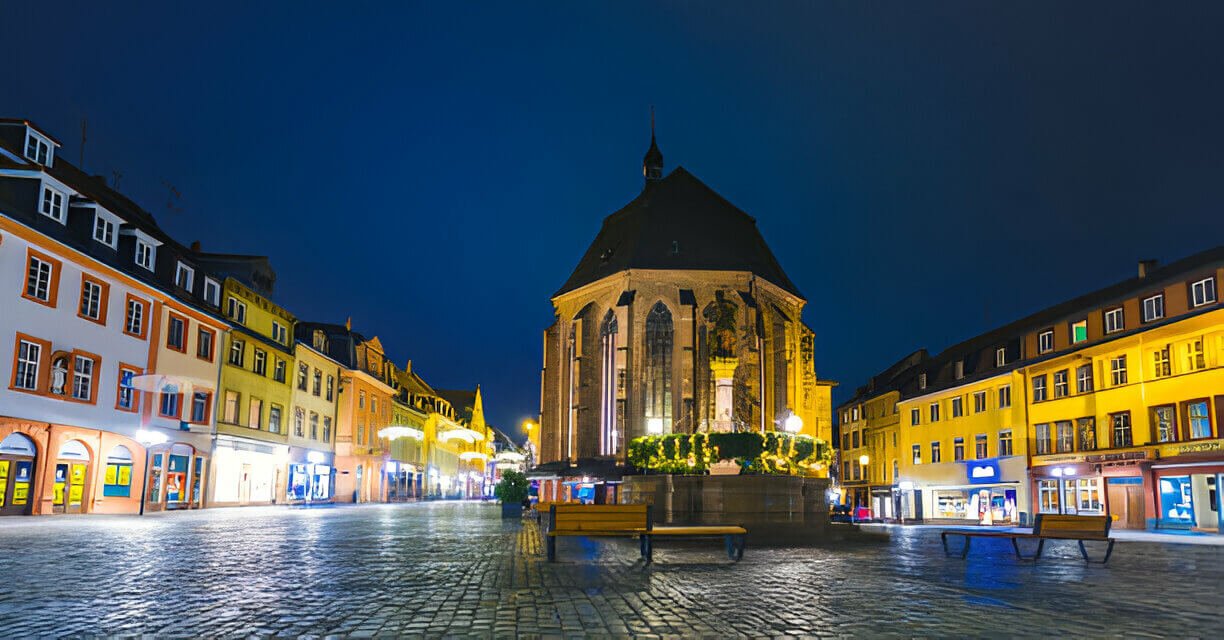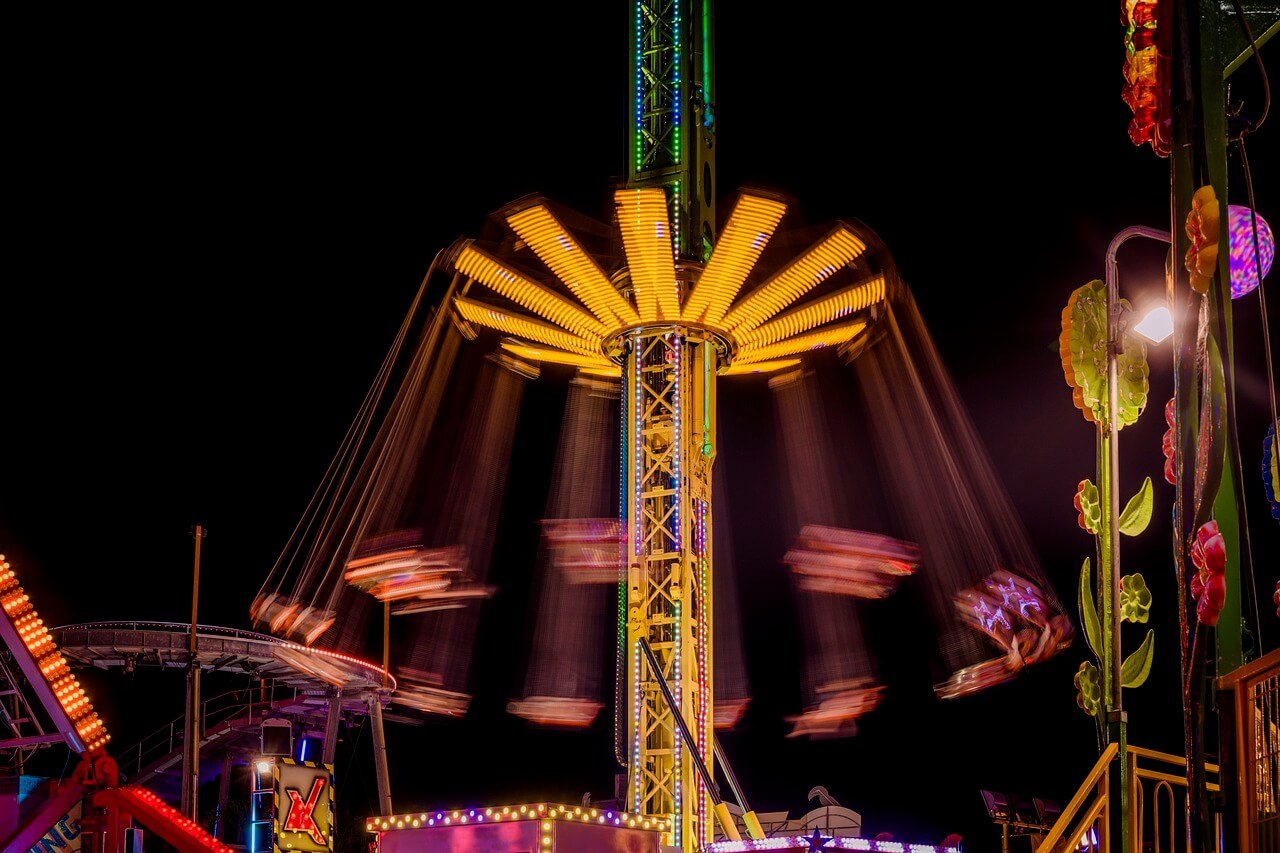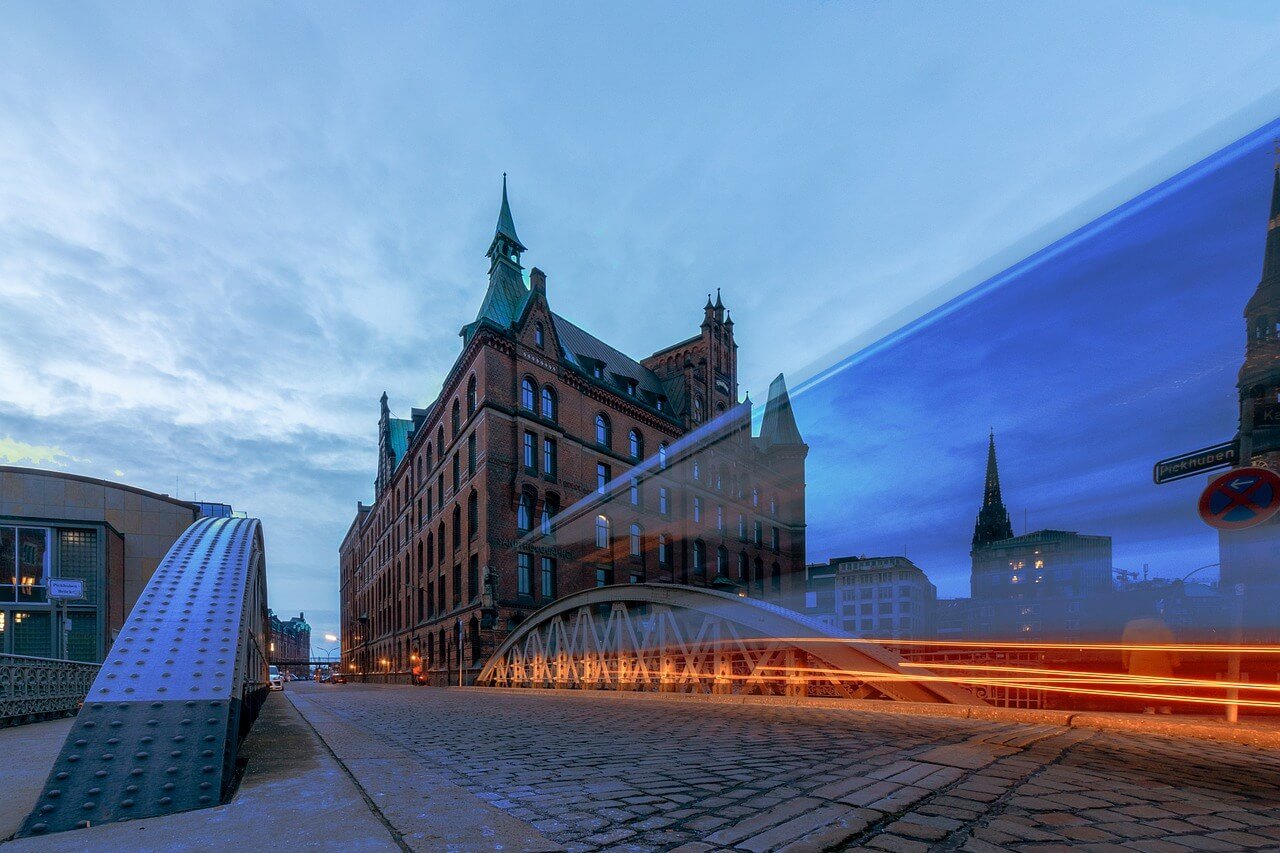Dresden, a city in Germany’s far east, is regarded as one of the most visually stunning in the nation. Due to its extensive collection of exquisite art and architecture, the city was dubbed the Jewel Box prior to suffering significant damage during World War II. The majority of Dresden’s tourist attractions, including internationally recognized sites like the beautiful Zwinger Palace and the Semper Opera House, have not yet undergone complete restoration after many years.
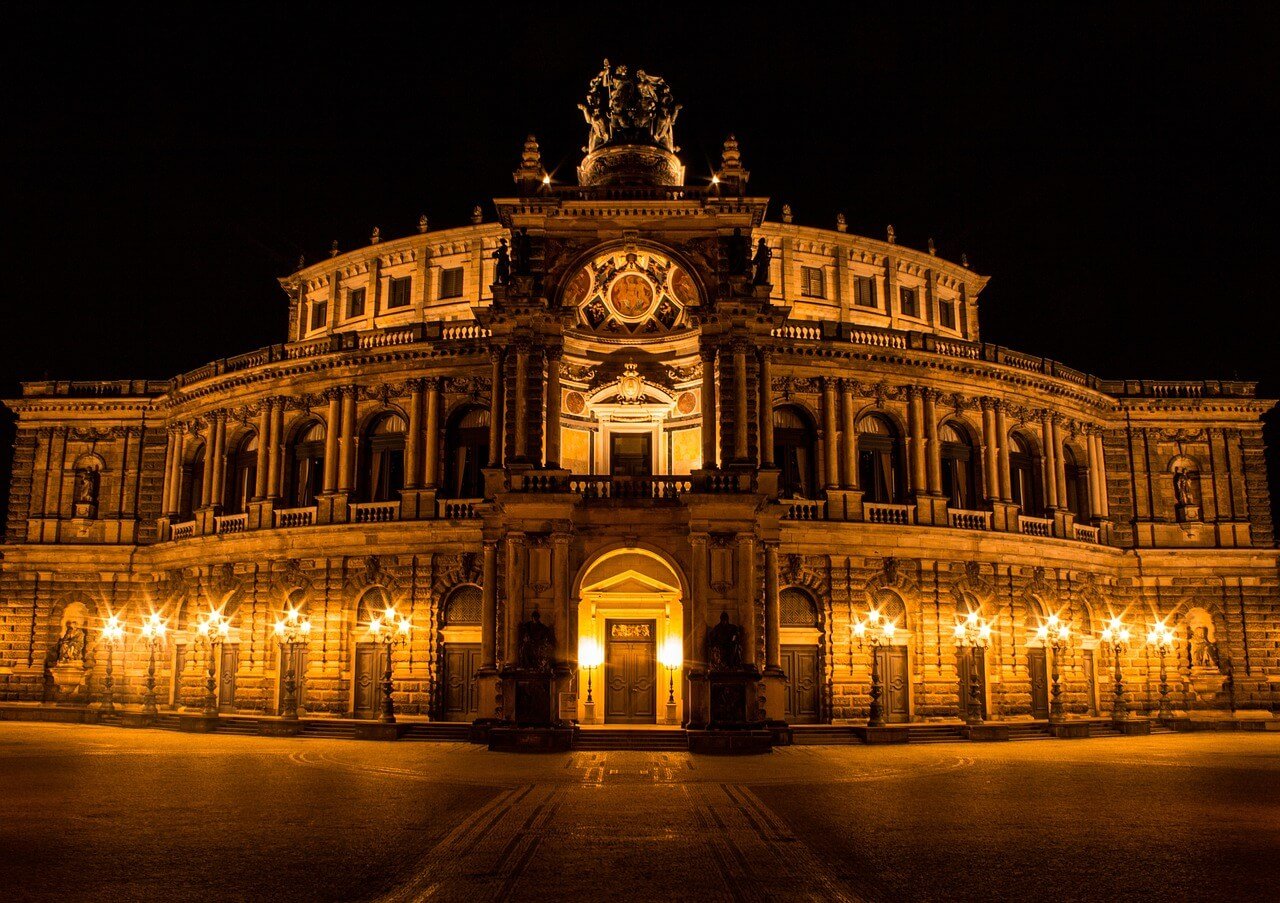
The city exudes a grand and regal aura due to its baroque and rococo influences. Admire the Old German architecture and get ready to be taken back in time to a time when science, art, and culture were thriving as you meander around the cobblestone streets.
The best activities in Dresden, nevertheless, are not limited to sightseeing and architecture. In addition to the breathtaking architecture, there is a thriving nightlife, world-class museums, and mouthwatering food. The Free State of Saxony’s capital, Dresden, is located along the picturesque Elbe River. This amazing city is a veritable marvel of architecture and culture.
23. Striezelmarkt

A must-see if you’re going to be in the area during Advent is the Dresdner Striezelmarkt! One of the most well-known and historic Christmas markets in Germany, the Striezelmarkt dates back to the fifteenth century. Situated in the center of the city’s ancient Old Town, the market is a joyous extravaganza.
Showcasing an abundance of adorned wooden booths with an extensive selection of merchandise. A classic Christmas cake consisting of dried fruits, nuts, spices, and powdered sugar is offered by numerous vendors along the market street.
This is the cake that gave rise to the name “Striezel” for the market. If you’re unable to attend the celebration, you can still eat this festive fruit dessert year-round at Bäckerei Emil Reimann Eiscafé in Old Town, which resembles a baked bread loaf coated in snow.
22. Transport Museum Dresden

Ever ponder how a Zeppelin is able to soar through the skies? Or maybe you want to know how the railway developed and how far it traveled across Germany?
Your curiosity will be satiated by everything from intricate blueprints to cutting-edge flight physics and the discoveries discovered during the war effort. The Saxon court utilized the building as a stable in 1586, which is when the building’s Renaissance facade was designed. The Transport Museum was established in 1952.
Naturally, the inside has been totally redesigned to accommodate the several multimedia learning sites and exhibitions, some of which are rotating and some of which are permanent. Situated right in the middle of Old Town, it’s a simple must-see that you can cross off your list as you explore the city.
21. Trip to Koenigstein Fortress
Want to spend some time away from it all by leaving the city? Or ought I to say, above all of it? Standing 240 meters above the Elbe River is the huge fortification known as Festung Königstein.
Perched atop a sizable sandstone plateau, this castle towers over the surrounding terrain, making it an incredibly defensible location in all of Europe. The region has been inhabited since the Bronze Age, and references to this magnificent mountain stronghold originate from 1233–1241.
The most common way to get from Dresden to the Fortress is by tour train, although you can also go there by vehicle, bus, or boat. The journey from Dresden Hauptbahnhof Station to Königstein Bahnhof Station takes approximately forty minutes. You should then ride a shuttle bus up the steep ascent to the Koenigstein Fortress entrance from there.
It should be noted that there are several well-known hiking routes in this vast area, so whether you use a shuttle or not, you should prepare for some walking.
20. Pfunds Molkerei
For any art historian with a penchant for cream, this intricately hand-painted dairy business is a must-see. They sell the tastiest cheese on earth. The Pfund brothers first opened this stunning spot in 1892. It is situated in the Eastern section of New Town.
Since then, it has been recognized as the “most beautiful milk shop in the world” and included to the Guinness Book of Records. boasts striking hand-painted tiles covering the walls, floors, and ceilings totaling 247.9 m².
The Café und Restaurant Pfunds, which offers a snack bar and a seating area in addition to a wider variety of dairy-made goods, is located right next door. There’s nothing quite like sipping a sophisticated glass of flawless milk and having a dessert created with the best dairy products to go with it.
19. Museum of Military History
You won’t want to miss the large Dresden Bundeswehr Museum of Military History if you’re particularly interested in the specifics of past combat. Discover Germany’s past and how the development of war machines paved the way for human progress in engineering here.
A five-story triangular rise on the left side of the exhibit floor is part of Daniel Libeskind’s 2011 extension to the primary exhibit, which is a chronological tour through German military history.
The Museum is located in a sprawling, tasteful complex of neoclassical buildings to the north of New Town. The Stauffenbergallee Tram Stop is the place to get off if you’re taking the tram uptown for a visit. The excellent museum can then be reached by walking north through the Denkmal der Roten Armee Memorial Park.
18. Green Vault
One of Europe’s largest treasure collections is kept in the Green Vault, also known as the Grünes Gewölbe. Housed at the Dresden Castle, it has almost four thousand objects. Magnificent artwork, including gold figurines and unique artifacts like gilded goblets crafted from ostrich eggs, can be seen inside this baroque palace.
In addition, an incredible assortment of gems and jewels, including the 41-carat Dresden Green Diamond, are on display there. The largest green diamond in the world, this apple-green stone is almost perfect.
17. Procession of Princes

A massive painting known as the Procession of Princes (Fürstenzug) is painted on the exterior wall of Dresden Castle’s stunning Stables Courtyard.
This outdoor artwork shows a procession that starts with Konrad the Great and features most of the Saxon rulers from 1127 to 1918. Wilhelm Walther, the artist, produced the original artwork between 1890 and 1876.
As the final figure in the Procession of Princes, the artist put himself in the painting. The sgraffito pottery method was used to produce the original. However, 25,000 Meissen ceramic tiles were used to replace the faded artwork, making it the largest porcelain mural in the world today.
16. Hofkirche

Augustus III, the Saxon emperor, constructed the Catholic Hofkirche in the eighteenth century to balance out the protestant Frauenkirche. Dresden’s Baroque church is among its most exquisite structures.
The initially constructed Dresden Cathedral was destroyed by Allied bombardment during World War II. In the 1980s, the authorities of East Germany restored it. Today, the pastel-colored and gold-trimmed church is once again able to awe visitors with its breathtaking splendor.
Another notable feature of the Dresden Cathedral is its peculiar spherical form. A portion of the ancient structure was preserved and used in the construction of the current building. Furthermore, as a reminder of the past, a charred and twisted cross that originally stood atop the dome has been positioned next to the alter.
15. Golden Rider

Standing towering in the center of a spacious courtyard made of stone and brick, the Golden Rider gleams in the midday light. In contrast to other well-known bronze statues that have gradually lost their luster, King August II’s gold platelet monolith continues to gleam.
This 1736 artistic monument is also known as The Statue of Augustus the Strong. Situated in the heart of the New Town Market, you’ll have plenty of options for dining and shopping in addition to the breathtaking view.
The surrounding streets provide a glimpse into the city’s past and present, and Galerie Gebr. Lehmann, located just east of the statue, is a great place to view fine art.
14. Pillnitz Palace
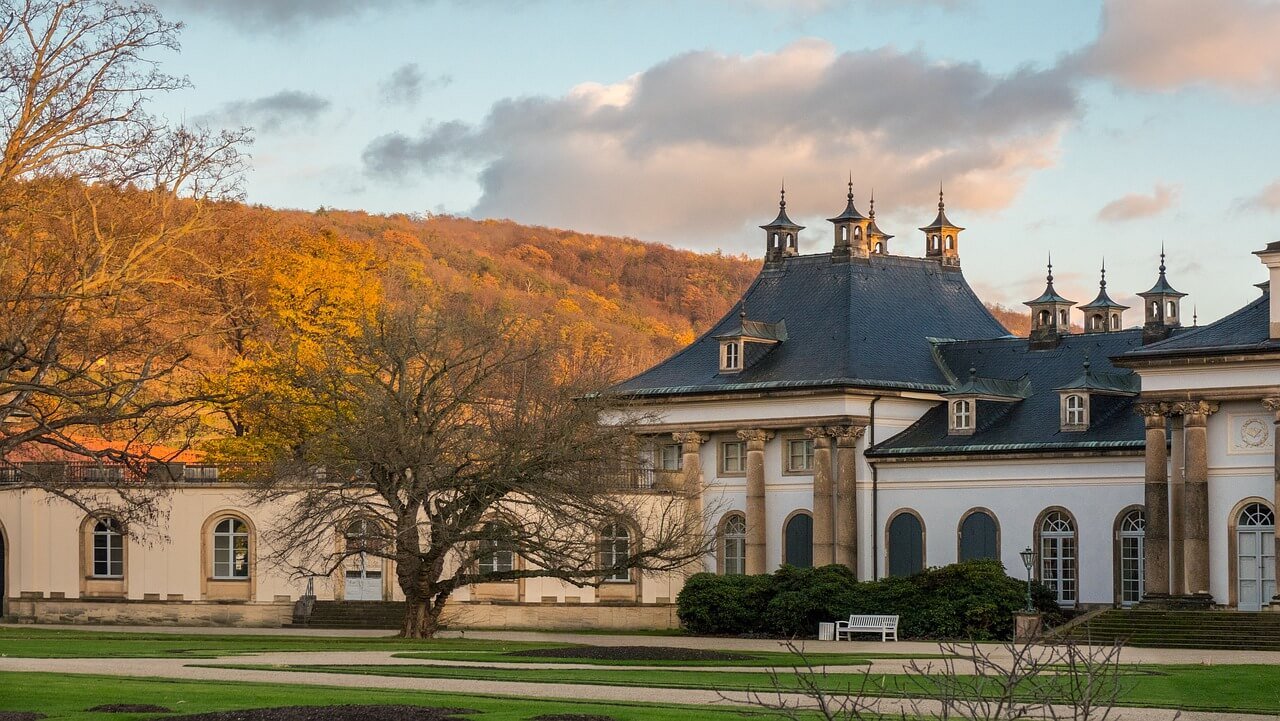
The Saxon royal family’s summer house was the Pillnitz Castle, which is on the banks of the Elbe River. Beautiful English gardens may be seen on the reconstructed royal site, which is actually home to three palaces: The Upper Palace, the New Palace, and the Riverside Palace.
These gardens are a great place for locals to spend a sunny afternoon or for a stroll because admission is free. Naturally, tourists also frequent these gardens frequently.
On the grounds of the Pillnitz Castle are the Dresden State Art Collections, the Arts and Crafts Museum, and the Palace Museum. Formerly a hamlet in Saxony, Pillnitz is now a Dresden district.
13. Japanese Palace
Famous Dresden art treasures are kept in the Japanisches Palais, a structure with an intriguing past, a preeminent cultural institution. Located on the Neustadt bank of the Elbe, this graceful structure is frequently eclipsed by the more well-known Altstadt side of the river, which boasts numerous architectural treasures situated in close proximity to one other.
Though this castle was important to Dresden during the Baroque era, its current humble appearance is not worthy of its distinguished past. This was the location where August the Strong (1670–1733) intended to build his “porcelain palace.” Almost everything, including the interior décor and roofs, was to be built of porcelain.
Following his purchase of the structure in 1717, he hired renowned Dresden architects Pöppelmann, de Bodt, Longuelune, and Knöffel to handle the modification. One of the greatest examples of Dresden Baroque architecture, the massive four-wing complex featured sculptures in the cutting edge “chinoiserie” style, together with Japanese bent roofs. The “porcelain palace” was never built to its full potential, nevertheless.
12. Cruise the Elbe River
Take a trip along the River Elbe in a paddle-wheel steamboat. There is no doubt that you will discover an aquatic adventure that suits your tastes among the many options available, including the Saxon Wine Route Steamer Day Cruise or the Pillnitz Castle Cruise.
An evening river cruise might be your best option if you’re searching for something a little more romantic. You and your significant other can spend a romantic evening by the river, complete with dinner, where the brilliant lights reflecting off the placid water will transport you back to the picturesque Le Sen in Paris.
11. Semper Opera House
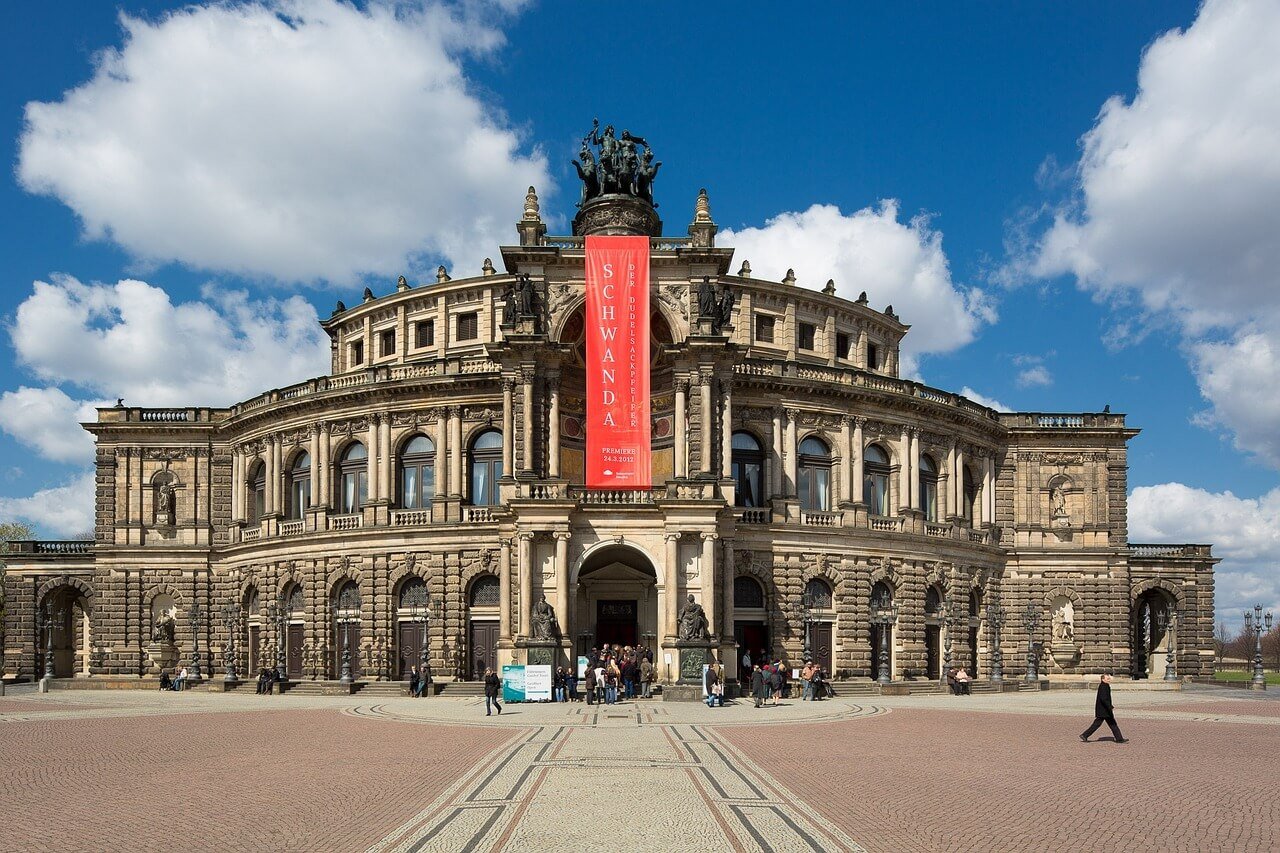
Situated in Dresden’s historic center, the Semper Opera House, often known as the Semperoper, is a striking example of baroque architecture, having been constructed in 1841. Gottfried Semper, the architect, is honored in the name.
The Saxon State Orchestra and the Semperoper ballet call the Semper Opera House home. Throughout its history, the building has undergone multiple reconstructions.
A portion of the building was damaged by fire in 1869, and the building was largely destroyed by Allied bombing in 1945. The Semper Opera House was meticulously reconstructed, incorporating only a few contemporary amenities. On February 13, 1985, precisely 40 years after it was destroyed, it reopened.
The building suffered damage from the neighboring Elbe River flood in 2002. After repairs, it is now available for tours.
10. Zwinger Palace

Constructed between 1710 and 1732, this remarkable collection of buildings is situated across the street from Dresden Castle.
The Zwinger, which consists of six magnificent pavilions, was initially the location of numerous court events in addition to tournaments. The palace is now home to multiple museums, one of which has a sizable collection of ceramics and the other includes an arsenal that displays Germany’s armaments.
Next is the Semperbau wing, which offers visitors a feast for the eyes with paintings by Old Masters including Raphael, Rubens, and Van Dyck. The Crown Gate is one of Zwinger’s most well-known and frequently photographed attractions. Both this gate and Zwinger’s exquisite Nymphaeum fountain are examples of baroque masterpieces.
09. Frauenkirche
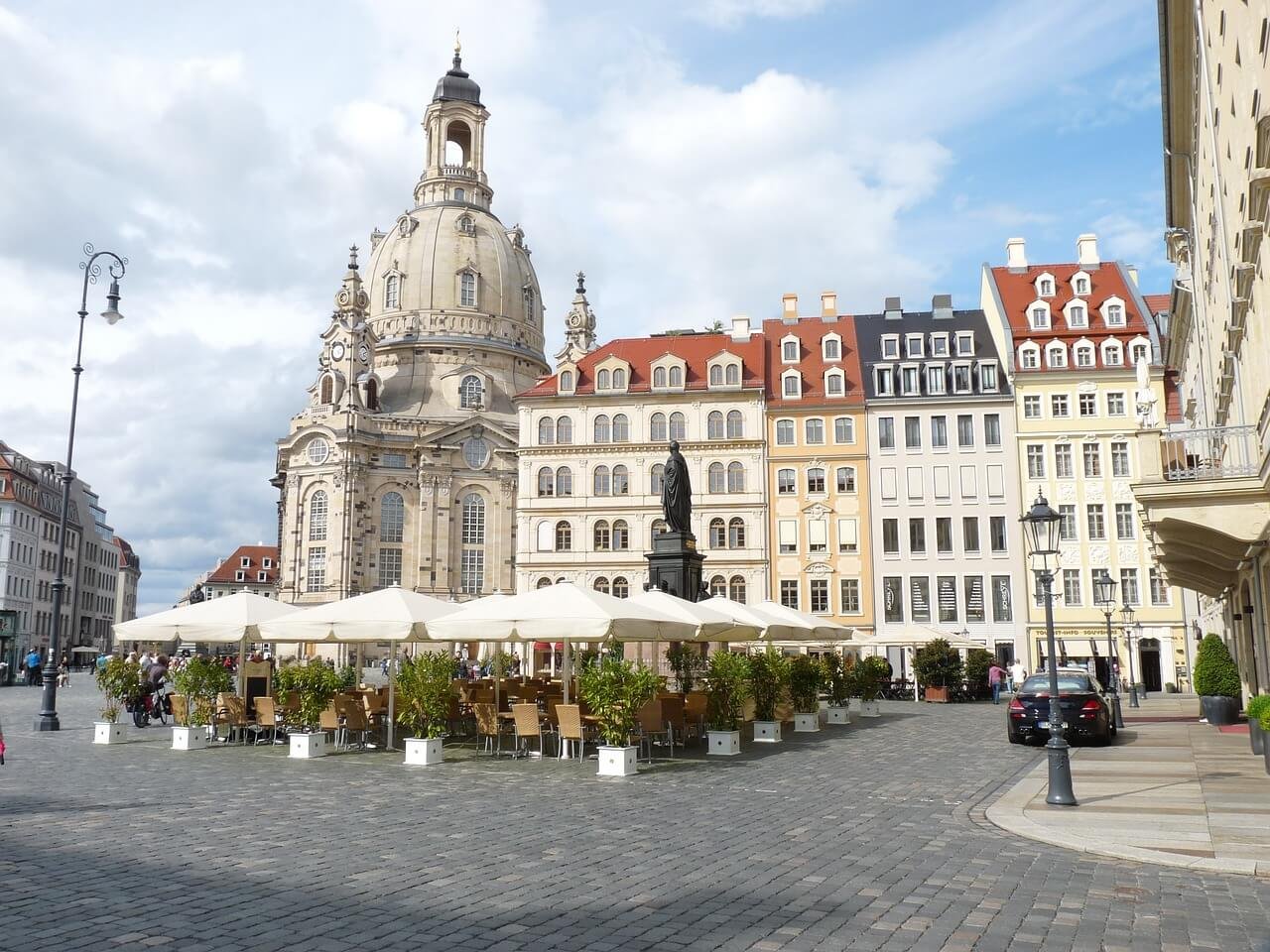
The Frauenkirche, or Church of Our Lady, is one of Dresden’s most well-known tourist destinations. It is a Lutheran church that dates back to the 18th century. The magnificent dome, which was completed in 1738, is made up of two casings that form the inner and outer shells of a double shell.
The church stood as a beautiful landmark in Dresden for two centuries until crumbling following the bombing in February 1945. Following Germany’s reunification, a grassroots initiative assisted in raising money for the iconic landmark’s reconstruction. Reopened in 2005, the church was rebuilt based on original 1720s blueprints.
The golden cross for the church’s dome was provided by the Luftwaffe-attacked city of Coventry. You can climb the dome. Visitors can take in breathtaking views of Dresden and the Elbe River from the summit.
08. Albertinum
The Albertinum is a stately art museum situated on the northeastern edge of Old Town, renowned for its expansive Renaissance structure. The structure, which bears King Albert of Saxony’s name, was originally an armory until Carl Adolf Canzler, a skilled builder in the area, altered its layout in the sixteenth century.
The link still has a few original items from the Albertinum’s early years of exhibition, and is home to many lovely statues from Romanticism to the present. In 2010, the museum reopened and underwent extensive renovations, making it better than before.
The museum, which just added the New Masters Gallery, takes pride in its support of up-and-coming elite artists from our own day. You’ll discover that the original Sculpture Collection and the New Masters Gallery dance together in a harmonious display of master artistry.
07. Deutsches Hygiene-Museum
It’s interesting to note that Dresden is home to the German Hygiene Museum, a particularly special medical museum. The battle for good health, well-being, and cleanliness among humans is as old as history. Knowing what it was like to work in the medical industry even 200 years ago will shock you.
A large portion of Europe used to even believe that taking a bath was unclean. As you can already see, there can be a lot more surprises to discover when visiting the Deutsches Hygiene-Museum than what one might initially believe. A keen scientific mind would want to visit this area, which is full of surprises for both parents and children and is located just east of Old Town.
06. Panometer Dresden
Take in the past in 306 degrees! Take the most distinctive voice-guided tour to learn about Dresden’s city art and architecture up close. You will be surrounded by lights and transported to a bygone era of Dresden with this amazing audio-visual experience.
At the Panometer’s annual anniversary celebration, explore the Dresden of 1756 as if it were a life-sized painting, or stroll across the panorama of a devastated Dresden following World War II bombardment.
Please be aware that the location is southeast of the town and that the tickets can be expensive. But this is the spot you should put on your list of things to do in Dresden if you want to experience something unique that you won’t find anyplace else in the globe.
05. Hike in Saxon Switzerland National Park
A riverboat journey along the Elbe is one of the most well-liked routes to reach Saxon Switzerland National Park. Hiking through the recognizable stony and fissured canyon terrain is a very unique experience.
An ideal destination for hikers, the recognizable protruding sandstone cliffs offer an abundance of stunning panoramic views! The hike that is most recommended is Bastei Bridge, which allows you to cross the River Elbe 194 meters above the ground. It’s also rather near to the Bastei bus stop and free of charge.
Other suggested treks are the extremely difficult Bad Schandau hike, the Bielatal Trail, Stolpen Castle, and the Malerweg Trail (also known as Painters’ Trail). It’s a good idea to prepare yourself by researching and learning what to expect from each terrain part before heading out with your GPS to go on an adventure of your own.
04. Grosser Garten
During the warmer months, the fittingly called Grosser Garten (Great Garden) is a tranquil haven. The Summer Palace, a 17th-century Baroque masterpiece, is the focal point of the park.
It is among Germany’s first instances of Baroque architecture. Since 1814, the area surrounding the palace has served as a public park. Currently Dresden’s largest park, it is home to the Botanical Garden, where guests can explore a wide variety of trees, shrubs, and flowers, as well as the Zoo Dresden. There is a tiny train that runs around the park from April to October.
03. Kunsthofpassage
The vibrant and creative Kunsthofpassage area is situated in Dresden’s Neustadt student zone and serves as a showcase for modern art.
The route is made up of multiple courtyards where people can wander past buildings with wacky paint jobs. The “Courtyard of Elements” is one of the most well-known. The “singing” drain pipes are an incredible aspect of this vivid blue picture.
This bright blue building’s intricate gutter system creates “music” when it rains. Another patio has animated animals, such as monkeys, decorating it. The Kunsthofpassage is renowned for its charming little cafes and boutiques.
02. Bruehl’s Terrace
The Bruehl Terrace (Brühlsche Terrasse), a tiered promenade with views of the Elbe River, is a well-liked meeting place known for being dubbed “The Balcony of Europe.”
It was formerly a component of Dresden’s defenses. However, a lovely garden was created out of the ramparts between 1739 and 1748. Today, tourists love ambling down the promenade, admiring the breathtaking scenery, and taking in the striking architecture and statues in the neighborhood.
Along the terrace are a number of ancient structures, such as the Supreme Court of Saxony (Sächsisches Ständehaus) and the Academy of Fine Arts (Kunstakademie). It’s a popular location for viewers as well.
01. Royal Palace
The Residenzschloss, sometimes called Dresden Castle, is a magnificent 14th-century Renaissance-style palace. It was reconstructed after the 1701 fire devastated it, and it is currently unquestionably one of Germany’s most stunning homes. The State rooms, the white English staircase, the Boulle furnishings, and everything in between show how affluent the previous Dresden kings were.
Visitors can find a variety of exhibits and displays within the palace. The legendary Green Vault, rich with gems and gold, is the pinnacle of Dresden Castle’s luxury. The Copperplate Engraving Cabinet, which houses a sizable collection of prints and drawings from the Renaissance, is a must-see for art fans.
The Turkish Chamber is another fascinating space in the Royal Palace. Magnificent textiles, costumes, and objects in the Ottoman style that were formerly presents from diplomatic contacts with the Ottoman Empire are on display in this exhibition.
Guests exploring the Royal Palace will also find the Rüstkammer, or Armory, an incredible collection of weaponry, armor, and militaria from the Renaissance. Augustus II the Strong, the Elector of Saxony, wore a suit of armor that is particularly beautiful in this collection.
How to get there
The main route into the city is via Dresden Airport (DRS). Direct flights are available from major European cities like Frankfurt, Paris, and London to the international airport. Travelers can take a taxi or the S2 train from the airport to go to the city center.
Dresden has two major train stations: Dresden-Neustadt station and Dresden Hauptbahnhof (main station) if you prefer to travel by rail. Berlin, Prague, and Vienna, among other German and European cities, are directly connected to both stations. You’ll get in Dresden quickly if you take a seat and take in the beautiful travel.
For a more affordable option, buses are a great way to get to Dresden. Routes connecting the city with other cities in Germany and Europe are offered by numerous long-distance bus operators, including RegioJet and Flixbus.
Where to Stay in Dresden
There are many great lodging alternatives in Dresden to suit a variety of preferences and price ranges.
If you enjoy an artistic and historic atmosphere, you might want to check out the Innere Neustadt district. The architectural marvels in this area are quite delightful. Additionally, it is conveniently located to a number of Dresden’s well-known attractions.
As an alternative, you might stay at Altstadt, which is in the center of Dresden. Because of the excellent hotels in this region and its close proximity to well-known locations, you can easily go sightseeing from your comfortable home. Check visit Äußere Neustadt if you’re seeking for more reasonably priced lodging without sacrificing accessibility. It’s a vibrant center with restaurants, bars, and creative surroundings.
The Leonardo Hotel is a fantastic low-cost choice with a range of accommodations ideal for the solo traveler or the whole family. If you’d like, you can even bring your furry travel companion with you because they’re pet-friendly. Situated near Mitte Station and on the fringe of Friedrichstadt neighborhood, it is situated northwest of Old Town.
Located next to Old Town and just on the banks of the Elbe River, the Maritim Hotel is a well-regarded intermediate lodging option. Any vacationing couple would be pleased to stay at the Maritim Hotel, which boasts classic elegance and is only 8 minutes’ walk from Dresden Castle. You could want to find yourself at the restaurant Wintergarten or the hotel bar after some downtime.
Best Time to Visit Dresden
Dresden is most beautiful from May to September, when temperatures range from 19 to 24°C (66 to 75°F), the sun is beaming, and everything is lush and green. The warm weather means there are loads of enjoyable events and outdoor activities to enjoy, even if the city is at its busiest (and most expensive) during this time.
The largest jazz event in Europe, the Dixieland event, and the massive Bunte Republik Neustadt street party are among the highlights. In addition, you can walk and rock climb among the park’s striking rocks or take picturesque boat rides to the Saxon Switzerland National Park.
Even though the weather is uncertain, April and October nevertheless see a good number of visitors outside of these months. Although it usually stays between 13 and 14°C (55 and 57°F), its breezes can occasionally bring on unexpectedly cold spells. The many parks in the city are pleasant to stroll around if it’s warm, especially in the fall when the buds are starting to open.
One of Germany’s oldest Christmas markets, the Striezelmarkt, draws thousands of visitors to Dresden each December, while the rest of the year is incredibly quiet. It was established in 1434 and is primarily known for its delicious Stollen fruitcakes and glowing candles that illuminate nearly every window in the community.
Approximate travel times:
Leipzig – 1 hour by car, 1 hour by train
Prague (Czech Republic) – 2 hours by car, 2 hours by train
Berlin – 2 hours by car, 2 hours by train
Nuremberg – 3.5 hours by car, 3 hours 30 minutes by train
Vienna (Austria) – 5 hours by car, 6 hours by train
Munich – 4 hours by car, 4 hours by train
Frankfurt – 4 hours by car, 4 hours by train
Hamburg – 4.5 hours by car, 5 hours by train


